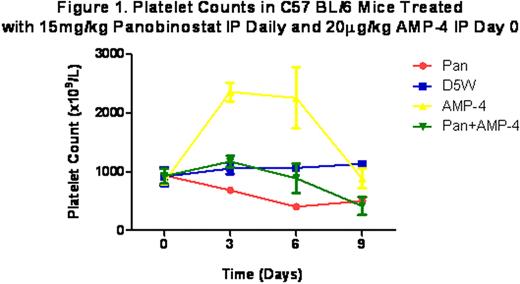Abstract
Abstract 2416
Poster Board II-393
Histone Deacetylase inhibitors (HDACi) are novel anti-cancer drugs with efficacy in T-cell lymphoma, myeloid malignancies and Hodgkin lymphoma. We have previously demonstrated that reversible thrombocytopenia (TCP) is a dose-limiting toxicity (Ellis et al Clin Cancer Res 2007) of HDACi which may limit broader use of these drugs especially in combination strategies. We have developed in vivo models which recapitulate this clinical scenario.
Administration of both the pan-HDACi panobinostat and the class I HDAC-selective inhibitor romidepsin (depsipeptide) in C57BL/6 mice induces a dose-dependant reduction in platelet number, which nadir on day 5 (from ∼1000×109/L to ∼300×109/L). Drug cessation results in a rebound thrombocytosis (∼1500×109/L) with counts normalizing after a week. We have compared and contrasted these observations with a single dose of carboplatin 100mg/kg (a chemotherapeutic agent inducing TCP by megakaryocyte ablation), and daily ABT-737 75mg/kg (a BH3 mimetic causing direct platelet apoptosis).
In contrast to HDACi, ABT-737 caused a 60% decrease in platelet counts after 2 hours, while carboplatin-induced TCP was not seen until 7 days. Circulating platelet half life studies in HDACi treated mice showed no difference to carboplatin, in contrast to ABT-737, with a >50% reduction after 2 hours. HDACi treated mice showed reductions of new reticulated platelets, using a thiazole orange uptake assay, from 6-8% to 1-2% within 24 hours. ABT-737 caused a rapid and sustained increase (6-8% to 20-30%) in reticulated platelets, and carboplatin a reduction from 6-8% to 2-3%. HDACi induced TCP with the same kinetics and nadir in BAK-/- mice as well as in mice reconstituted with Bak-/-/Bak-/- hemopoietic stem cells which are relatively insensitive to ABT-737. Bone marrow sections showed HDACi and ABT-737 to induce a significant increase in megakaryocyte number while carboplatin resulted in a significant reduction, further indicating that HDACi-induced TCP is due to a platelet production or release defect rather than myeloablation. All drugs caused an increase in thrombopoietin (TPO) levels. Our data therefore suggests HDACi impair platelet production, and not direct platelet apoptosis. These effects are likely to be induced by inhibition of HDAC's 1 and/or 2 as the effects of panobinostat are mirrored by romidepsin. We postulated that our observations are akin to those seen in immune thrombocytopenia (ITP). AMP-4 is a mouse-specific TPO-mimetic with an activating peptide structurally identical to romiplostim, an agent licensed to treat ITP. A single subcutaneous dose of AMP-4 in mice results in marked thrombocytosis peaking at 4-5 days at ∼3000×109/L, normalizing by 9-10 days. When AMP-4 is administered to mice at initiation of (Figure 1), or during ongoing treatment with panobinostat or romidepsin, there is a clear and consistent improvement in platelet numbers to levels similar to untreated controls.
Thus we have demonstrated for the first time that HDACi-induced TCP can be ameliorated by the use of TPO-mimetics. Such a strategy when applied in the clinic has the potential to overcome a substantial clinical limitation of HDACi-therapy. Data will be available for the effects of HDACi on murine megakaryocytes derived from embryonic fetal liver cells, and pro-platelet formation from these cells, an essential intermediary step to platelet release. We aim to define the megakarocyte cellular targets of HDACi- induced TCP in both in vivo and in vitro models, scrutinizing the effects of AMP-4 on these systems.
Platelet Counts in C57 BL/6 Mice Treated with 15 mg/kg Panobinostat IP Daily and 20μ g/kg AMP -4 IP Day 0
Platelet Counts in C57 BL/6 Mice Treated with 15 mg/kg Panobinostat IP Daily and 20μ g/kg AMP -4 IP Day 0
Off Label Use: panobinostat and romidepsin are both histone deactylase inhibitors, in clinical studies for haematological malignancies. niether are licensed for use in any setting currently. Prince:Gloucester Pharmaceuticals: Consultancy. Johnstone:Novartis, Merck, Gloucester: Research Funding.
Author notes
Asterisk with author names denotes non-ASH members.


This feature is available to Subscribers Only
Sign In or Create an Account Close Modal